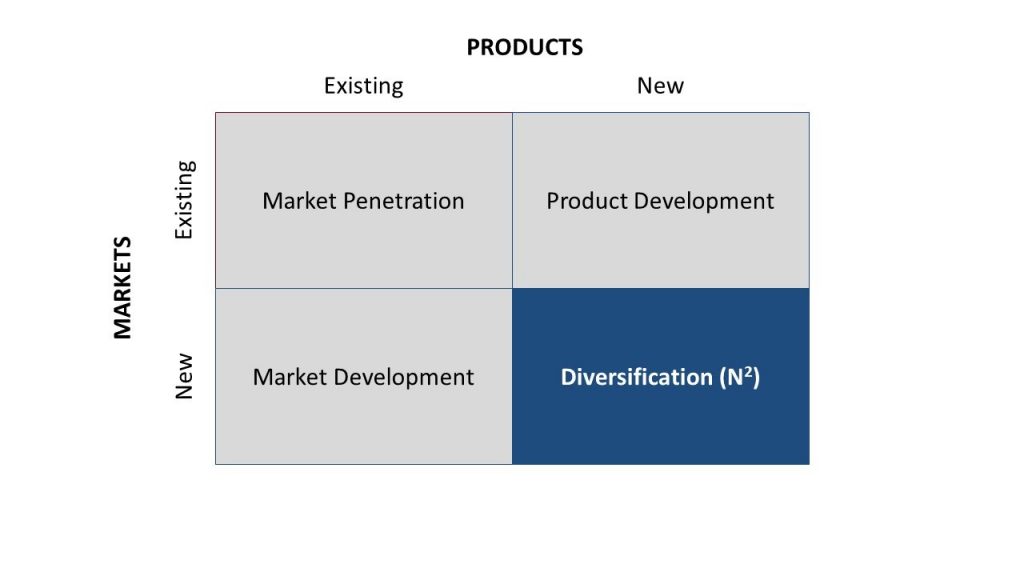Tasked with Running an Early-Stage New Business Development Organization? Here are the 10 Things You Need to Know
Growth strategy comes in essentially four forms: developing new products for existing customers; selling existing products to new customers; convincing existing customers to buy more of existing products; or developing new products to sell to new customers. The riskiest and most difficult of these options is, of course, the latter, commonly referred to “diversification” or “new-new” growth strategy.
 When pursuing new-new opportunities, an organization exposes itself to both technical and commercial uncertainty: in order to achieve its goals, it must simultaneously navigate unfamiliar dynamics and channels, court novel and unknown customers, build value propositions from scratch, and manage the technical risk associated with investing in new product development. Opportunities to fail are many and varied; chances of success are dauntingly slim.
When pursuing new-new opportunities, an organization exposes itself to both technical and commercial uncertainty: in order to achieve its goals, it must simultaneously navigate unfamiliar dynamics and channels, court novel and unknown customers, build value propositions from scratch, and manage the technical risk associated with investing in new product development. Opportunities to fail are many and varied; chances of success are dauntingly slim.
And yet, new-new opportunities also provide the most fertile ground for exciting, fresh advancement, and no company serious about innovation can ignore the promise that exists beyond the limited universe of their current customers and product lines.
Logistically speaking, going after new-new opportunities often requires establishing a distinct early-stage new business development organization, separate from individual business units or R&D directorates. Sometimes arising as an outgrowth of divisional strategy, sometimes as a corporate initiative, this group operates as the growth mechanism for the company as a whole, going out into the world and investigating new markets and ideas in order to gain enough knowledge to enter those spaces with confidence. Newry has worked with many of these early-stage NBD organizations, and we’ve learned some important lessons about what works well (and what doesn’t). Some key ideas:
1. Find entrepreneurial leadership
New-new innovation is not for the faint of heart, and it takes a special kind of leader to run an early-stage new business organization successfully. To face such a high level of risk and failure on a daily basis requires a certain indomitable spirit, a thick-skinned-ness that can withstand repeated disappointment and frustration in the course of pursuing big breakthroughs. It’s tough to find folks who are up to this task – especially because, in addition to dogged determination, the leaders of your new-new organization must also possess charisma and enough credibility within the organization to yank everyone else along with them into the scary and unfamiliar world of the new-new. Nevertheless, identifying and recruiting these rare individuals is critical to success.
2. Fight to attract and keep the best people
It is very difficult to staff a new-new organization with highly talented people; success is not guaranteed and is often not even correctly attributed, so top-notch folks are tough to attract and keep. There’s no easy solution to this problem – exceptional minds don’t grow on trees and never will, and many (if not most) great entrepreneurial spirits prefer to work for themselves – but we have noticed that the brilliant individuals who tend to stick around at our clients are those who are naturally responsive to the idea of working for a cause that is bigger than themselves, and who are given (relatively) free reign to pursue their passions. Your early-stage NBD organization cannot compete with VC money or fame; it can, however, provide an environment that attracts self-selecting, curious individuals who are genuinely passionate about the bigger picture; who thrive on high-risk/high-reward stakes; who simply love bringing new things into being.
3. Secure funding for the long haul and pace investment appropriately
Patience is your friend for new-new growth strategy. Customers control adoption and decide when they want new things, not suppliers, so building longevity into your investment plan is key. One big watch-out: there’s no faster way to destroy credibility and support for an early-stage new business development organization than to overspend on tech-based new-new innovation, so keep early-stage investment in check until it is essential to go full-throttle.
4. Establish top-level sponsorship and keep them close – but not too close
C-suite support is key to sustaining a new-new organization, but relationships with high-level advocates require careful management. Executive champions need to be sufficiently engaged to feel committed, but if you allow them to become too involved in the day-to-day decision-making, their natural, results-driven orientation will have them seeking to speed up and drive what is generally a messy, inexact, and often frustratingly slow entrepreneurial process – an outcome that is in no one’s best interests.
5. Adopt specialized early-stage screening approaches and investment criteria
Investment metrics that are common for established businesses, such as discounted cash flow and ROI, are essentially useless in very early-stage innovation. There are simply too many unknowns for these financial projections to serve as dependable benchmarks, and relying on them is more likely to lead you astray than not.
It’s worth focusing instead on addressable market, value proposition, and competitiveness, three very basic parameters that can reveal a great deal about your likelihood of future success, and help make and enforce go/no-go decisions. Is the total addressable market big enough to be worth your while? Can you clearly articulate the unique and differentiated attributes of your technology, and will customers value it? Who else is playing in the space, and do you – no kidding – have what it takes to beat them?
6. Keep your opportunity hopper full
Fresh ideas, new opportunities, and novel problems to solve are the lifeblood of new-new efforts; without them, your early-stage new business organization is hosed. As such, you should be actively generating ideas at all times, not just when you need them. Even when your pipeline is full to overflowing, make sure new thoughts are still being produced – preferably via several different scouting and ideation processes – and then catalog those concepts and save them for later. It’s a lot easier to be objective about the value of an opportunity when you’ve got a lot of others to stack it up against.

You should be generating new ideas for your early-stage new business development organization at all times
7. Focus on overall portfolio performance, not “hits” and “misses”
It’s not about batting averages – it’s about runs scored. Hit rates in early-stage innovation organizations are routinely less than 10%, but a single big hit can more than compensate for dozens of misses. As such, focusing on the times you strike out can be unnecessarily demoralizing – and probably doesn’t reflect how well your organization is really doing.
That being said, success demands a lot of experiments, so create a pipeline with lots of options and kill “losers” ruthlessly. As I’ve discussed previously, ending bad projects is not where you fail – keeping bad projects around in the hopes that they will somehow turn into big wins is the behavior that will get you into trouble.
8. Make your “receivers” your friends
A critical part of accelerating the product development process is ensuring that receiving groups within the organization know what’s coming down the pike. It’s all well and good to invent an ingenious new coating technology and send a sample along to wow some potential new customers, but if you haven’t established a clear plan for scaling up production beforehand, then you’ll be up a creek when your first big order comes in.
Keeping your receivers engaged informally throughout is good, but with long development timelines and bureaucratic policies for customer engagement, it’s not always easy: many of our biggest clients – some of the most sophisticated materials companies in the world – struggle to keep lines of communication open between Research, Development, Engineering, and beyond. It is crucial to ensure that your organization has a truly robust receivership system for long-term innovations, as well as a mechanism to hand off adjacencies that inevitably arise throughout the process.
9. Be paranoid about direct and indirect competitors
If there is any one thing most likely to sink an early-stage new business development effort, it is lack of attention to competition. Competitors are always more threatening and relevant than you think, and IP is rarely sufficient to provide lasting competitive advantage. Again and again, we have seen clients move into a new space with a new product and fail – not because their product was not excellent, and not because they weren’t perfectly capable of developing strong relationships with new customers, but because their knowledge of existing players was imperfect, and their attitude toward likely competitive response was blasé.
The solution here is no more complicated than cultivating a healthy sense of suspicion towards your own assumptions about what your opponents can and cannot (and will and will not) do. Push yourself and your team to consider where, exactly, your in-kind rivals would have to fall short in order for you to steal share from them. Do you understand their position in the ecosystem? Do you have a robust sense for the quality of their relationships in the value chain? Have you been diligent in determining – perhaps with the help of an independent, objective source – what their priorities for the future are?
10. Keep your new-new organization small and separate
“Skunk works” are a tried and true mechanism for creating new businesses within a larger business. By keeping new-new efforts physically separate and organizationally distinct from the day-to-day business organization, you can avoid breakthrough innovations getting caught up in and chewed up by the gears of procedural bureaucracy and ensure that they get out into the market faster and more smoothly.
Find out how Newry can help your organization move smarter to move faster. Get traction in your market.